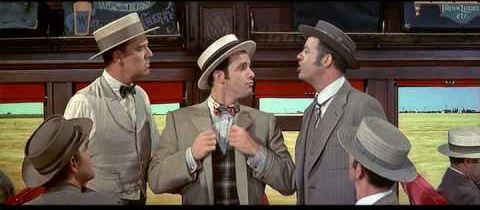


02/13/2014
Steve Sailer’s blog post Today In White Guilt: White Guy Wins Hip-Hop Grammy; Another White Guy Worries About It At Length
From: Thomas McCarthy
I often find that reading Steve Sailer’s stuff is the only way I can keep myself informed as to what things interest (1) those white Americans who are genuinely delighted about embracing minority status in the country their forebears built and (2) the New and Improved Americans who expect soon to replace the aforementioned white folks — not to mention me and you and lots of other whites, too.
As I read, greatly bemused, his piece about hip-hop/rap "artists" of whom I knew literally nothing, I was struck by the tongue-in-cheek pocket history of rap’s roots that concluded the article and illustrated it with several videos of particular interest, I would imagine, to ethnographers and other people with too much time on their hands. Then it struck me that Mr. Sailer might have omitted from his list of sources what could easily be the white progenitor of hundreds or even thousands of individual raps: "Rock Island," the brilliant opening number in Meredith Willson’s celebrated 1957 musical, The Music Man.
Trust me, I know whereof I speak. When I was younger, I had the remarkable ability to clear entire rooms when, with very little provocation, I would start declaiming "it’s the Model T Ford made the trouble, made the people wanna go, wanna git, wanna git, wanna git up and go seven, eight, nine, ten, twelve, fourteen, twenty-two, twenty-three miles to the county seat / yes sir, yes sir / who’s gonna patronize a little bitty two-by-four kinda store anymore?"
Anyone not yet driven to madness or thoughts of justifiable homicide would soon after be treated to "gone with the hogshead cask and demijohn, gone with the sugar barrel, pickel barrel, milk pan, gone with the tub and the pail and the tierce" and later "he’s just a bang-beat, bell-ringin', big-haul, great-go, neck-or-nothin', rip-roarin', every time a bull’s-eye salesman. That’s Professor Harold Hill, Harold Hill."
The truest and most direct inspiration on later rap art, however, was surely the oft-repeated "whaddayatalk, whaddayatalk, whaddayatalk, whaddayatalk, whaddayatalk, wheredayagetit, whaddayatalk, whaddayatalk, whaddayatalk, wheredayagetit?" which incorporates all the wisdom, mature reflection, and sympathy for the human condition that has drawn millions of white folks to embrace the hip-hop gospel in all its grandeur and authenticity.
And to think that a white dude from Mason City, Iowa, thought it all up on his lonesome.
See previous letters from Thomas McCarthy